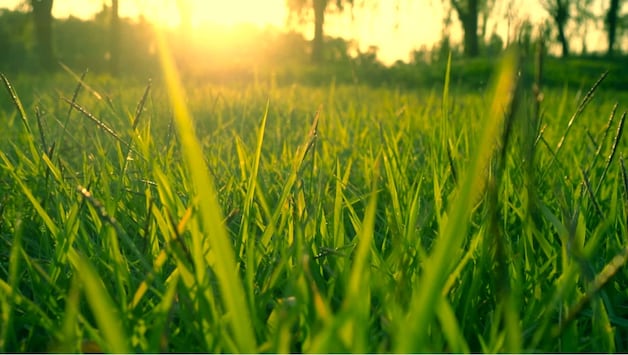When should the lawn be fertilized and scarified? Depending on your point of view, the right time can vary: We’ll show you how to achieve the perfect lawn.
In the garden, expectations and reality can sometimes diverge – especially when it comes to lawn care. Unfortunately, it is not enough to just leave it to itself, to the rain and the sun.
In spring, the lawn needs a beauty treatment.
Fertilizing the lawn is the first task in March and April. The important nutrients for grass include nitrogen (N), phosphorus (P), potassium (K) and magnesium (M)
These terms or letters can be found in different combinations in the lawn mixes available on the market. In long-term mixes, for example, these nutrients are combined in such a way that the lawn gets everything it needs throughout the spring and summer. The German Lawn Society recommends the first fertilization with these around mid-April.
However, the weather is not the same every year. Sometimes there is longer winter weather, sometimes spring temperatures come earlier. The best time to fertilize is therefore the start of the growing season in a region. And this can be determined much more precisely.
For example, with the grassland temperature sum (GTS), which is used by farmers to determine when to start their field work. The positive daily mean temperatures from January 1st are added together. The values in January are multiplied by a factor of 0.5, those in February by 0.75. From March onwards, the full daily values are used.
If the total reaches 200 degrees, the soil is considered warm enough to grow. Fertilization therefore makes sense, as the grass can absorb the nitrogen in the fertilizer without any losses. But fertilization is also possible at a value of 170.
Do you find it too time-consuming to keep statistics every day? The states and agricultural chambers of Germany have joined forces to form the Information System for Integrated Plant Production (ISIP) association. ISIP maintains a map with the values. Green dots in a location represent a value of 200 or more. If you click on them, you can read the specific values.
A second fertilization of purely ornamental lawns takes place in July. If the lawn is subject to more stress, for example from children playing, the Lawn Society recommends three rounds of fertilization – in April, June and August. For grasses in the shade of trees, there should also be at least three fertilizations.
A good two to three weeks after fertilizing and shortly after the second cut, the lawn can be scarified – this is the second part of the lawn treatment in spring.
At first, scarifying seems like destroying the area that is slowly becoming greener again, because it removes dead or superfluous material such as moss from between the grasses. What remains is a thinned-out lawn.
But the measure is important, otherwise the area will become matted. This would have consequences for the water and fertilizer absorption and the air exchange. It could also be that the roots then grow shallower and the grass is more susceptible to disease.
For this you use a scarifier – a type of mower with vertically rotating blades or wires. If you don’t have one, you can rent one from a hardware store. Some lawn mowers also have a special setting for this. And if you only have a small lawn, you can simply do the work with a hand scarifier, a type of rake or rake.
The Saxon Garden Academy recommends cutting the lawn to a height of around two centimetres before scarifying. It is best to then scarify the area once lengthways and once crossways. If the lawn is very damaged and has large bare patches, it is worth reseeding.















